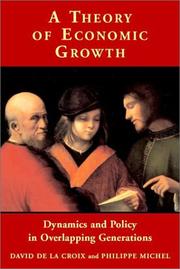| Listing 1 - 10 of 65 | << page >> |
Sort by
|
Book
ISBN: 3732993965 Year: 2020 Publisher: Berlin, Germany : Frank & Timme GmbH,
Abstract | Keywords | Export | Availability | Bookmark
 Loading...
Loading...Choose an application
- Reference Manager
- EndNote
- RefWorks (Direct export to RefWorks)
Book
ISBN: 0262526107 0262016729 9786613594488 0262301555 1280499257 9780262301558 9781280499258 9780262016728 0262300796 9780262526104 Year: 2012 Publisher: Cambridge, MA MIT Press
Abstract | Keywords | Export | Availability | Bookmark
 Loading...
Loading...Choose an application
- Reference Manager
- EndNote
- RefWorks (Direct export to RefWorks)
How America went bankrupt and how we can save ourselves--as a country and as individuals--from economic disaster.
Budget deficits -- United States. --- Fiscal policy -- United States. --- Generational accounting -- United States. --- United States -- Economic conditions -- 21st century. --- Budget deficits --- Generational accounting --- Fiscal policy --- Business & Economics --- Economic History --- United States --- Economic conditions --- Generational accounts --- Finance, Public --- Accounting --- E-books --- 330.973
Book
ISBN: 9783486594560 Year: 2003 Publisher: De Gruyter
Abstract | Keywords | Export | Availability | Bookmark
 Loading...
Loading...Choose an application
- Reference Manager
- EndNote
- RefWorks (Direct export to RefWorks)
Lange war man bemüht, jegliche Subjektivität aus dem Schreiben von Geschichte auszuschließen. Kulturhistorische und andere Neuansätze der Geschichtswissenschaft haben jedoch deutlich gemacht, dass wir letztlich immer auch vor dem Hintergrund unserer eigenen Lebenserfahrungen und der uns verfügbaren Geschichten anderer Menschen argumentieren. Eine Möglichkeit, die Summe solcher Lebenserfahrungen und Geschichten zu kategorisieren, erschließt sich über den Begriff der Generation bzw. Generationalität.
Generations --- Intergenerational relations --- Conflict of generations --- Gap, Generation --- Generation gap --- Generational conflict --- Intergenerational conflict --- Social conflict --- Intergenerational relationships --- Relations, Intergenerational --- Relationships, Intergenerational --- Interpersonal relations --- Age groups
Book
ISBN: 0520964551 9780520964556 9780520295117 9780520290372 0520290372 0520295110 Year: 2017 Publisher: Oakland, California
Abstract | Keywords | Export | Availability | Bookmark
 Loading...
Loading...Choose an application
- Reference Manager
- EndNote
- RefWorks (Direct export to RefWorks)
In this comprehensive and abundantly illustrated book, Allan A. Schoenherr describes the natural history of California-a state with a greater range of landforms, a greater variety of habitats, and more kinds of plants and animals than any area of equivalent size in all of North America. A Natural History of California focuses on each distinctive region, addressing its climate, rocks, soil, plants, and animals. The second edition of this classic work features updated species names and taxa, new details about parks reclassified by federal and state agencies, new stories about modern human and animal interaction, and a new epilogue on the impacts of climate change.
Natural history --- backpackers. --- california. --- classic work. --- climate change. --- comprehensive guide. --- explorers. --- generational. --- hikers. --- history. --- landforms. --- lifetime. --- mountains. --- natural history. --- new epilogue. --- north america. --- outdoors guide. --- scientists. --- wildlife. --- yosemite.
Book
ISBN: 1781700729 1847791417 9781847791412 9781781700723 9780719077364 0719077362 Year: 2008 Publisher: Manchester New York New York Manchester University Press Distributed exclusively in the USA by Palgrave Macmillan
Abstract | Keywords | Export | Availability | Bookmark
 Loading...
Loading...Choose an application
- Reference Manager
- EndNote
- RefWorks (Direct export to RefWorks)
Living in sin' is the first book-length study of cohabitation in nineteenth-century England, based on research into the lives of hundreds of couples. 'Common-law' marriages did not have any legal basis, so the Victorian courts had to wrestle with unions that resembled marriage in every way, yet did not meet its most basic requirements. The majority of those who lived in irregular unions did so because they could not marry legally. Others chose not to marry, from indifference, from class differences, or because they dissented from marriage for philosophical reasons. This book looks at each moti.
Unmarried couples --- History --- Victorian courts. --- class differences. --- cohabitation. --- common-law marriages. --- couples. --- generational differences. --- indifference. --- irregular unions. --- marriage. --- nineteenth-century England.

ISBN: 1134621299 1280333154 9786610333158 0203020782 020317108X 9780203171080 9780203020784 6610333157 9780415207706 0415207703 9780415463270 0415463270 0415207703 9781134621248 9781134621286 9781134621293 1134621280 Year: 2007 Publisher: London Routledge, Taylor & Francis Group
Abstract | Keywords | Export | Availability | Bookmark
 Loading...
Loading...Choose an application
- Reference Manager
- EndNote
- RefWorks (Direct export to RefWorks)
The ageing of Western societies has provoked extensive sociological debate, surrounding both the role of the state and whether it can afford the cost of an ageing population, and the role of the family, especially women, in supporting older people. In this important book, the authors examine how changes, such as cuts in welfare provision, migration, urbanization and individualisation influence intergenerational relations. The collection addresses theoretical and policy issues connecting age and generation with the family and social policy, and focuses both on cross-cultural compariso
Intergenerational relations --- Conflict of generations --- Gap, Generation --- Generation gap --- Generational conflict --- Intergenerational conflict --- Generations --- Social conflict --- Intergenerational relationships --- Relations, Intergenerational --- Relationships, Intergenerational --- Interpersonal relations --- Age group sociology --- Europe --- Western world
Book
ISBN: 1634858506 9781634858502 9781634858243 Year: 2016 Publisher: Hauppauge, New York
Abstract | Keywords | Export | Availability | Bookmark
 Loading...
Loading...Choose an application
- Reference Manager
- EndNote
- RefWorks (Direct export to RefWorks)
Work ethic. --- Values. --- Conflict of generations --- Gap, Generation --- Generation gap --- Generational conflict --- Intergenerational conflict --- Generations --- Intergenerational relations --- Social conflict --- Axiology --- Worth --- Aesthetics --- Knowledge, Theory of --- Metaphysics --- Psychology --- Ethics --- Ethic, Work
Book
ISBN: 3030660737 3030660729 Year: 2021 Publisher: Springer Nature
Abstract | Keywords | Export | Availability | Bookmark
 Loading...
Loading...Choose an application
- Reference Manager
- EndNote
- RefWorks (Direct export to RefWorks)
This open access book examines the significance of gay neighborhoods (or ‘gayborhoods’) from critical periods of formation during the gay liberation and freedom movements of the 1960s and 1970s, to proven durability through the HIV/AIDS pandemic during the 1980s and 1990s, to a mature plateau since 2000. The book provides a framework for contemplating the future form and function of gay neighborhoods. Social and cultural shifts within gay neighborhoods are used as a framework for understanding the decades-long struggle for LGBTQ+ rights and equality. Resulting from gentrification, weakening social stigma, and enhanced rights for LGBTQ+ people, gay neighborhoods have recently become “less gay,” following a 50-year period of resilience. Meanwhile, other neighborhoods are becoming “more gay,” due to changing preferences of LGBTQ+ individuals and a propensity for LGBTQ+ families to form community in areas away from established gayborhoods. The current ‘plateau’ in the evolution of gay neighborhoods is characterized by generational differences—between Baby Boom pioneers and Millennials who favour broad inclusivity—signaling various possible trajectories for the future ‘afterlife’ of these important LGBTQ+ urban spaces. The complicating impacts of the COVID-19 pandemic provides a point of comparison for lessons learned from gay neighborhoods and the LGBTQ+ community that bravely endured the onset of the HIV/AIDS pandemic. This book will be of interest to students and scholars in various disciplines—including sociology, social work, anthropology, gender and sexuality, LGTBQ+ and queer studies, as well as urban geography, architecture, and city planning—and to policymakers and advocates concerned with LGBTQ+ rights and social justice.
Regional & area planning --- Gender studies, gender groups --- Agricultural economics --- Landscape/Regional and Urban Planning --- Gender and Sexuality --- Urban Economics --- Geography --- Gender Studies --- Regional and Spatial Economics --- LGBTQ --- Neighbourhood Planning --- Urban Change --- Generational Change --- Urban Planning --- Gentrification --- Open Access
Book
ISBN: 082327182X 0823271862 0823271854 0823271846 Year: 2016 Publisher: New York, NY : Fordham University Press,
Abstract | Keywords | Export | Availability | Bookmark
 Loading...
Loading...Choose an application
- Reference Manager
- EndNote
- RefWorks (Direct export to RefWorks)
The elite young men who inhabited northern antebellum states—the New Brahmins—developed their leadership class identity based on the term “character”: an idealized internal standard of behavior consisting most importantly of educated, independent thought and selfless action. With its unique focus on Union honor, nationalism, and masculinity, Northern Character addresses the motivating factors of these young college-educated Yankees who rushed into the armed forces to take their place at the forefront of the Union’s war. This social and intellectual history tells the New Brahmins’ story from the campus to the battlefield and, for the fortunate ones, home again. Northern Character examines how these good and moral “men of character” interacted with common soldiers and faced battle, reacted to seeing the South and real southerners, and approached race, Reconstruction, and Reconciliation.
Character. --- College students --- History --- New England --- United States --- Civilization --- Intellectual life --- Social aspects --- Civil War. --- Class. --- College men. --- Generational Conflict. --- Honor. --- Leadership. --- Masculinity. --- Nationalism. --- Nineteenth Century Colleges and Universities. --- Social Identity.

ISBN: 0521806429 0521001153 1107131251 0511119739 0511041780 0511148372 0511302649 0511606435 1280154926 0511044194 9780511041785 9780511148378 9780511119736 9780511606434 9780511044199 9781280154928 9786610154920 6610154929 9780521806428 9780521001151 Year: 2002 Publisher: Cambridge New York Cambridge University Press
Abstract | Keywords | Export | Availability | Bookmark
 Loading...
Loading...Choose an application
- Reference Manager
- EndNote
- RefWorks (Direct export to RefWorks)
Provides an in-depth treatment of the overlapping generations model in economics incorporating production. Chapter 1 investigates competitive equilibria and corresponding dynamics: existence and uniqueness of equilibrium, global dynamics of capital (including poverty traps), and various extensions of the model. Chapter 2 analyzes the optimality of allocations in this framework, using both the value function and marginal approaches. Optimality with unbounded growth is also analyzed. Policy issues including the Second Welfare Theorem, pensions, government spending, and optimal taxation, are discussed in chapter 3. The notion of public debt is introduced in chapter 4 and the sustainability of policies with budget deficits/surpluses is examined. The last chapter presents extensions of the model including altruism, education/human capital, and habit formation. Methodological emphasis is put on using general preferences and technologies, on the global study of dynamic aspects of the model, and on furnishing adequate tools to analyze policies involving inter-generational transfers.
Macroeconomics --- Economic development --- Economic policy --- Generational accounting --- AA / International- internationaal --- 304.4 --- 338.8 --- 331.04 --- 304.2 --- Cyclische veranderingen. --- Economische groei. --- Langdurige bewegingen. --- Trendanalyse. Tendenties van lange duur. --- Economic policy. --- Macroeconomics. --- Economic Theory --- Business & Economics --- 330.35 --- 338.22 --- Generational accounts --- Finance, Public --- Economic nationalism --- Economic planning --- National planning --- State planning --- Economics --- Planning --- National security --- Social policy --- Development, Economic --- Economic growth --- Growth, Economic --- Statics and dynamics (Social sciences) --- Development economics --- Resource curse --- Economische groei. Kwantitatieve toename. Technische vooruitgang --zie ook {338.09} --- Economische organisatieleer. Economisch beleid. Economische politiek --- Accounting --- Economic development. --- Generational accounting. --- Business, Economy and Management --- 339 --- 338.22 Economische organisatieleer. Economisch beleid. Economische politiek --- 330.35 Economische groei. Kwantitatieve toename. Technische vooruitgang --zie ook {338.09} --- Trendanalyse. Tendenties van lange duur --- Cyclische veranderingen --- Langdurige bewegingen --- Economische groei --- Développement économique --- Histoire économique --- Macroéconomie --- Politique économique --- Développement économique --- Histoire économique --- Macroéconomie --- Politique économique
| Listing 1 - 10 of 65 | << page >> |
Sort by
|

 Search
Search Feedback
Feedback About UniCat
About UniCat  Help
Help News
News